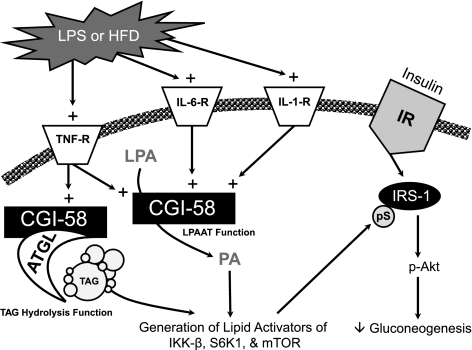FIG. 5.
Proposed model for CGI-58’s integrated role in inflammatory responses and insulin action in the liver. In response to inflammatory stimuli, such as an HFD or LPS, plasma levels of inflammatory cytokines, such TNFα, IL-1β, and IL-6, are increased. These inflammatory cytokines normally signal through their membrane-bound receptors (TNF-R, IL-6-R, and IL-1-R) to promote CGI-58–driven generation of signaling lipids either directly from LPAAT activity or indirectly by coactivating ATGL to generate lipid signals from TAG hydrolysis. CGI-58–generated PA, and likely other signaling lipids, can subsequently act as a critical second messenger to promote the activation of inflammatory stress kinases, such as IKK-β, S6K1, and mTOR. Collectively, these activated stress kinases (IKK-β, S6K1, and mTOR) can facilitate serine phosphorylation (pS) of critical serine residues (Ser307, Ser612, Ser632, and Ser1101) on IRS-1, thereby dampening hepatic insulin signaling. Knocking down CGI-58 diminishes this potent negative regulatory loop, thereby improving hepatic insulin action. IR, insulin receptor. TNF-R, TNF receptor.

